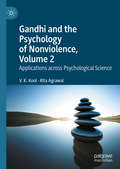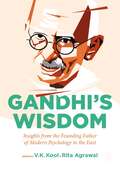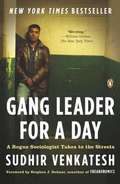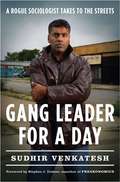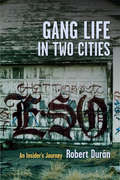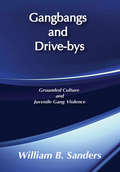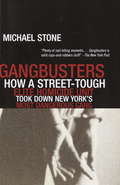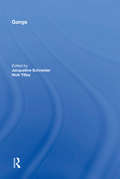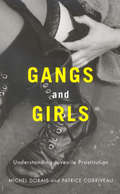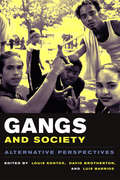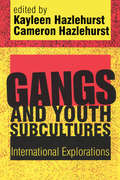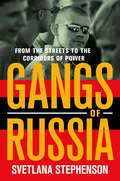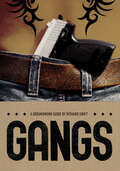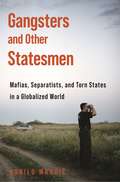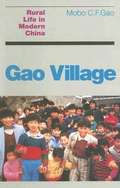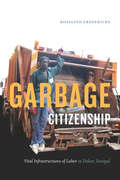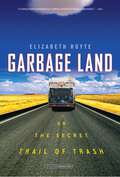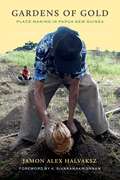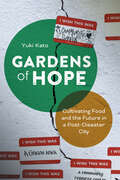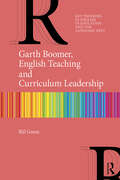- Table View
- List View
Gandhi and the Psychology of Nonviolence, Volume 2: Applications across Psychological Science
by Rita Agrawal V. K. KoolIn volume 1 of Gandhi and the Psychology of Nonviolence the authors advanced a scientific psychology of nonviolence, derived from principles enunciated by Gandhi and supported by current state-of-the-art research in psychology. In this second volume the authors demonstrate its potential contribution across a wide range of applied psychology fields. As we enter the era of the Anthropocene, they argue, it is imperative to make use of Gandhi’s legacy through our evolving noospheric consciousness to address the urgent problems of the 21st century. The authors examine Gandhi’s contributions in the context of both established areas such as the psychology of religion, educational, community and organizational psychology and newer fields including environmental psychology and the psychology of technology. They provide a nuanced analysis which engages with both the latest research and the practical implications for initiatives like the Intergovernmental Panel on Climate Change and the UN’s Sustainable Development Goals.The book concludes with an overview of Gandhi’s contribution to modern psychology, which encompasses the history, development, and current impetus behind emerging work in the field as a whole. It marks an exciting contribution to studies of both Gandhi and psychology that will also provide unique insights for scholars of applied psychology, education, environmental and development studies.
Gandhi’s Wisdom: Insights from the Founding Father of Modern Psychology in the East
by V. K. Kool Rita AgrawalThis book examines what Gandhian thought contributes to the conceptualisation of wisdom and its application in the 21st Century. It draws together leading international researchers and practitioners to combine an in-depth understanding of Gandhi’s philosophy with the latest research from psychology and allied social sciences. Beginning with an overview of wisdom in the domain of scientific research and as it is understood in our everyday life, the book’s editors further call attention to key cross cultural issues limiting its current scope. Amongst the topics explored are Gandhi’s silence, fasting, vows, self-efficacy, self-control, and more, illustrating what he offers not only to the study of wisdom within psychology, but across a broad range of disciplines and professional enterprises. It is invaluable to students and scholars of Gandhian studies, the psychology of wisdom, management and peace psychology; as well to readers with a general interest in the application of Gandhi’s wisdom today.
Gang Leader for a Day
by Sudhir VenkateshA New York Times BestsellerForeword by Stephen J. Dubner, coauthor of FreakonomicsWhen first-year graduate student Sudhir Venkatesh walked into an abandoned building in one of Chicago's most notorious housing projects, he hoped to find a few people willing to take a multiple-choice survey on urban poverty--and impress his professors with his boldness. He never imagined that as a result of this assignment he would befriend a gang leader named JT and spend the better part of a decade embedded inside the projects under JT's protection. From a privileged position of unprecedented access, Venkatesh observed JT and the rest of his gang as they operated their crack-selling business, made peace with their neighbors, evaded the law, and rose up or fell within the ranks of the gang's complex hierarchical structure. Examining the morally ambiguous, highly intricate, and often corrupt struggle to survive in an urban war zone, Gang Leader for a Day also tells the story of the complicated friendship that develops between Venkatesh and JT--two young and ambitious men a universe apart."Riveting." --The New York Times"Compelling... dramatic... Venkatesh gives readers a window into a way of life that few Americans understand." --Newsweek"An eye-opening account into an underserved city within the city." --Chicago Tribune"The achievement of Gang Leader for a Day is to give the dry statistics a raw, beating heart." --The Boston Globe"A rich portrait of the urban poor, drawn not from statistics but from viivd tales of their lives and his, and how they intertwined." --The Economist"A sensative, sympathetic, unpatronizing portrayal of lives that are ususally ignored or lumped into ill-defined stereotype." --Finanical TimesSudhir Venkatesh's latest book Floating City: A Rogue Sociologist Lost and Found in New York's Underground Economy--a memoir of sociological investigation revealing the true face of America's most diverse city--was published in September 2013 by The Penguin Press
Gang Leader for a Day: A Rogue Sociologist Takes to the Streets
by Sudhir Alladi VenkateshGang Leader for a Day is the fascinating full story of how Sudhir Venkatesh managed to gain entrance into the gang, what he learned, and how his method revolutionized the academic establishment. When Venkatesh walked into an abandoned building in one of Chicago's most notorious housing projects, he was looking for people to take a multiple-choice survey on urban poverty. A first-year grad student hoping to impress his professors with his boldness, he never imagined that as a result of the assignment he would befriend a gang leader named JT and spend the better part of a decade inside the projects under JT's protection, documenting what he saw there. Over the next seven years, Venkatesh got to know the neighborhood dealers, crackheads, squatters, prostitutes, pimps, activists, cops, organizers, and officials. From his privileged position of unprecedented access, he observed JT and the rest of the gang as they operated their crack-selling business, conducted PR within their community, and rose up or fell within the ranks of the gang's complex organizational structure. In Hollywood-speak, Gang Leader for a Day is The Wire meets Harvard University. It's a brazen, page turning, and fundamentally honest view into the morally ambiguous, highly intricate, often corrupt struggle to survive in what is tantamount to an urban war zone. It is also the story of a complicated friendship between Sudhir and JT-two young and ambitious men a universe apart.
Gang Life in Two Cities: An Insider's Journey
by Robert J. DuránRefusing to cast gangs in solely criminal terms, Robert J. Durán, a former gang member turned scholar, recasts such groups as an adaptation to the racial oppression of colonization in the American Southwest. Developing a paradigm rooted in ethnographic research and almost two decades of direct experience with gangs, Durán completes the first-ever study to follow so many marginalized groups so intensely for so long, revealing their core characteristics, behavior, and activities within two unlikely American cities.Durán spent five years in Denver, Colorado, and Ogden, Utah, conducting 145 interviews with gang members, law enforcement officers, prosecutors, and other relevant individuals. From his research, he constructs a comparative outline of the emergence and criminalization of Latino youth groups, the ideals and worlds they create, and the reasons for their persistence. He also underscores the failures of violent gang suppression tactics, which have only further entrenched these groups within the barrio. Encouraging cultural activists and current and former gang members to pursue grassroots empowerment, Durán proposes new solutions to racial oppression that challenge and truly alter the conditions of gang life.
Gangbangs and Drive-Bys: Grounded Culture and Juvenile Gang Violence (Social Problems And Social Issues Ser.)
by William SandersThis study, based on quantitative and qualitative data gathered over a twelve-year period, takes its title from the two predominant styles of gang violence: 'drive-bys,' which have replaced 'rumbles' as the primary form of gang violence; and 'gang-bangs' - a generic term for other gang violence that includes assaults, knifings, and beatings.The author attempts to understand the situations in which a young man would drive up to another human being and, without further ado, blow his head off. By examining hundreds of such situations, and employing both structural and phenomenological analysis, Sanders explores the various configurations of gang violence.Gangbangs and Drive-bys also examines the routines of gang members and their view of life, the different styles of gangs, and changes undergone by gangs from the early 1980s to the end of the same decade. Over that period, the emphasis shifted from parties and paybacks to big money from the sale of rock cocaine, and from unstructured to organized crime. Along with that shift came an increase in the violence.Finally, Sanders traces the beginning and evolution of a metropolitan police gang unit over the same decade in order to present an inside view of how the police attempt to deal with and understand gangs.
Gangbusters: How a Street Tough, Elite Homicide Unit Took Down New York's Most Dangerous Gang
by Michael StoneIn the bestselling tradition of Nicholas Pileggi, Joseph Wambaugh, and Robert Daley's Prince of the City, a thoroughly enthralling story of how the seasoned veterans of New York's elite Homicide Investigation Unit took down the city's most dangerous drug gang, and in the process rewrote the book on tackling gang crime. Gangbusters is a riveting narrative about the secretive, elite Homicide Investigation Unit and its successful investigation and prosecution of the notorious upper Manhattan Wild Cowboys, one of the bloodiest and most violent drug gangs in New York's long history. For two years, veteran reporter Michael Stone was granted exclusive access to the inner workings of HIU, its brilliant and iconoclastic chief, Walter Arsenault, and the seasoned, street-smart detectives and prosecutors who helped to put the Wild Cowboys behind bars. The book opens with the shocking and senseless execution of a Tarrytown college boy on the West Side Highway. Over time, the case leads detectives to the Wild Cowboys, a drug gang whose size and penchant for violence and intimidation have terrorized the South Bronx and upper Manhattan for years. HIU's attempts to bring down the Wild Cowboys' ruthless leader, Lenny, and feared enforcers, Platano and Pasqualito, triggermen for scores of the gang's murders, posed challenges that would test the unit's very survival. But HIU's dedicated collaboration of prosecutors and detectives and the strategies Arsenault employed in the unit's investigation have since become a model for gang enforcement in cities around the world. In the end, the Wild Cowboys and their allies were responsible for more than sixty murders. A rich roller-coaster ride of a narrative with a colorful and, at times, heroic cast of characters, Gangbusters is true crime at its page-turning best.
Gangs (The\international Library Of Criminology, Criminal Justice And Penology Ser.)
by Jacqueline SchneiderThe task of researching gangs is fraught with difficulties, central to which are issues of definition and reliance on certain forms of data for analyses. These methodological issues have been acknowledged as limitations in most of the existing research, but they have not been explored as being potentially serious flaws contributing to the proliferation of myth, or as aggravating factors that exacerbate what is essentially a relatively uncomplicated social process. Also unclear from existing studies is the extent to which suppositions about gangs feed moral panics or contribute to the misidentification or over-specification of a problem. This captivating volume focuses on gangs, their formation, identity and behaviour with a view to developing a preventive strategy.
Gangs and Girls: Understanding Juvenile Prostitution
by Patrice Corriveau Michel DoraisThey discuss how young men are drawn to gang life, how young girls become attracted and attached to the gang members who eventually sell them into prostitution, and why it is so hard to infiltrate and dismantle the distinct but interrelated worlds of the procurer, victim, and client. Rooted firmly in first person testimony, this research deepens our understanding of juvenile prostitution by identifying and exploring the types of motivations and circumstances that lead teenagers into prostitution rings.
Gangs and Society: Alternative Perspectives
by David C. Brotherton Luis Barrios Eds. Kontos LouisCompiled by three leading experts in the psychological, sociological, and criminal justice fields, this volume addresses timely questions from an eclectic range of positions. The product of a landmark conference on gangs, Gangs and Society brings together the work of academics, activists, and community leaders to examine the many functions and faces of gangs today. Analyzing the spread of gangs from New York to Texas to the West Coast, the book covers such topics as the spirituality of gangs, the place of women in gang culture, and the effect on gangs of a variety of educational programs and services for at-risk youth. The final chapter examines the "gang-photography phenomenon" by looking at the functions and politics of different approaches to gang photography and features a photographic essay by Donna DeCesare, an award-winning journalist.
Gangs and Youth Subcultures: International Explorations
by Kayleen Hazlehurst Cameron HazlehurstGangs are growing in many different social, economic, and political environments coupled with an alarming breakdown of public order. Failures to contain or reduce gang crime in European, Asian, South American, African, and North American cities may be symptoms of fundamental problems threatening the fabric of many societies. The spread of gangs to suburbia and remote locations is a palpable, worldwide threat. But despite nearly a century of scholarly inquiry into street gangs and youth subcultures, no single work systematically reflects on comparative international experiences with gangs. Gangs and Youth Subcultures takes up this challenge. Kayleen Hazlehurst and Cameron Hazlehurst argue that theories of gang behavior in immigrant communities and the influence of transnational crime syndicates are better tested in more than one host society. Similar phenomena would be better understood if placed in a comparative context. To this purpose, the editors assembled expert scholars and policy advisers from North America, Europe, South Africa, and Australasia. Gangs and Youth Subculture lays the groundwork for an explanation of why gangs continue to grow in strength and influence, and why they have spread to remote locations.Kayleen Hazlehurst and Cameron Hazlehurst present new findings and innovative preventive strategies in a clear, concise fashion. No other work brings together experts on gangs and youth subcultures from so many countries. As such, this trailblazing book will interest scholars and teachers of criminology and sociology, justice system administrators, as well as law enforcement officers and youth workers internationally.
Gangs of Russia: From the Streets to the Corridors of Power
by Svetlana StephensonSince their spectacular rise in the 1990s, Russian gangs have remained entrenched in many parts of the country. Some gang members have perished in gang wars or ended up behind prison bars, while others have made spectacular careers off the streets and joined the Russian elite. But the rank and file of gangs remain substantially incorporated into their communities and society as a whole, with bonds and identities that bridge the worlds of illegal enterprise and legal respectability.In Gangs of Russia, Svetlana Stephenson explores the secretive world of the gangs. Using in-depth interviews with gang members, law enforcers, and residents in the city of Kazan, together with analyses of historical and sociological accounts from across Russia, she presents the history of gangs both before and after the arrival of market capitalism.Contrary to predominant notions of gangs as collections of maladjusted delinquents or illegal enterprises, Stephenson argues, Russian gangs should be seen as traditional, close-knit male groups with deep links to their communities. Stephenson shows that gangs have long been intricately involved with the police and other state structures in configurations that are both personal and economic. She also explains how the cultural orientations typical of gangs--emphasis on loyalty to one's own, showing toughness to outsiders, exacting revenge for perceived affronts and challenges--are not only found on the streets but are also present in the top echelons of today's Russian state.
Gangs, Guns and Knives: Activities and Lesson Plans to Raise Awareness with Young People Aged 14-19 about the Risks and Realities of Gang-Related Crime
by Vanessa RogersThis is an essential handbook for youth workers, teachers, social workers and youth justice practitioners working with young people to raise awareness about the risks and realities of gangs and gang-related crime.Each activity offers a different learning experience including quizzes, worksheets, games and interactive activities. The book explores peer pressure, loyalty and personal responsibility as well the impact that violent crime can have on individuals, family, community and wider society. It also considers the ethical and moral dilemmas of gang life, serious youth violence and crime and the potential consequences of gang membership and carrying a weapon.Written by a renowned youth worker and trainer, this essential book helps young people to separate myth from fact, build assertiveness and develop the skills to make safe choices.
Gangs: A Groundwork Guide (Groundwork Guides)
by Richard SwiftA Booklist Editors’ Choice and a Society of School Librarians International (SSLI) Honor Book Street gangs have exploded worldwide. Tattoos, baggy pants, tagging, gangsta style, the unspoken threat -- it's all just around the corner in most of the world's major cities. From the streets of Los Angeles to the shantytowns of Cape Town, hundreds of thousands of "at risk" youth are deciding whether they should join their local gang. Violence, guns, the drug trade, racism, poverty, families under pressure and ever-widening slums all provide a witch's brew in which the youth gang tempts young males and females with a sense of identity and belonging that their world has denied them. Gangs exposes the roots of the problem as it moves from the banlieues of France to the favelas of Brazil. It offers a startling analysis of the complicity of the official adult world and some controversial ideas for reforms that might just undermine the appeal of gang life. For many of the world's young -- especially those who are poor -- joining a gang is a real career choice. It is a choice that can be as deadly for young gangsters as for their victims. Richard Swift shows us that we fail to understand gangs at our peril.
Gangster Warlords: Drug Dollars, Killing Fields, and the New Politics of Latin America
by Ioan GrilloA new kind of criminal kingpin has arisen: part CEO, part terrorist, and part rock star, unleashing guerrilla attacks, strong-arming governments, and taking over much of the world's trade in narcotics, guns, and humans. What they do affects you now--from the gas in your car, to the gold in your jewelry, to the tens of thousands of Latin Americans calling for refugee status in the U.S. Gangster Warlords is the first definitive account of the crime wars now wracking Central and South America and the Caribbean, regions largely abandoned by the U.S. after the Cold War. Author of the critically acclaimed El Narco, Ioan Grillo has covered Latin America since 2001 and gained access to every level of the cartel chain of command in what he calls the new battlefields of the Americas. Moving between militia-controlled ghettos and the halls of top policy-makers, Grillo provides a disturbing new understanding of a war that has spiraled out of control--one that people across the political spectrum need to confront now.
Gangsters and Other Statesmen: Mafias, Separatists, and Torn States in a Globalized World
by Danilo MandićHow global organized crime shapes the politics of borders in modern conflictsSeparatism has been on the rise across the world since the end of the Cold War, dividing countries through political strife, ethnic conflict, and civil war, and redrawing the political map. Gangsters and Other Statesmen examines the role transnational mafias play in the success and failure of separatist movements, challenging conventional wisdom about the interrelation of organized crime with peacebuilding, nationalism, and state making.Danilo Mandić conducted fieldwork in the disputed territories of Kosovo and South Ossetia, talking to mobsters, separatists, and policymakers in war zones and along major smuggling routes. In this timely and provocative book, he demonstrates how globalized mafias shape the politics of borders in torn states, shedding critical light on an autonomous nonstate actor that has been largely sidelined by considerations of geopolitics, state-centered agency, and ethnonationalism. Blending extensive archival sleuthing and original ethnographic data with insights from sociology and other disciplines, Mandić argues that organized crime can be a fateful determinant of state capacity, separatist success, and ethnic conflict.Putting mafias at the center of global processes of separatism and territorial consolidation, Gangsters and Other Statesmen raises vital questions and urges reconsideration of a host of separatist cases in West Africa, the Middle East, and East Europe.
Ganzheitliche Gestaltung mobiler Arbeit (ifaa-Edition)
by ifaa – Institut für angewandte Arbeitswissenschaft e. V.Das zunehmende Interesse an mobiler Arbeit sowohl bei Unternehmen als auch bei Beschäftigten führt auf betrieblicher Ebene zu Gestaltungsherausforderungen. Aufgrund des heterogenen Verständnisses von mobiler Arbeit und den unterschiedlichen Motivationen der Beteiligten erscheint "die eine beste Lösung" zur Einführung von mobiler Arbeit im Betrieb nicht realistisch. Bereits gemachte Praxiserfahrungen untermauern diese These. Es existieren zwar vielfältige Unterstützungstools, die auch genutzt werden (können), diese Checklisten, Handlungshilfen etc. adressieren in der Regel aber nur ein relevantes Thema von vielen, bei der Einführung von mobiler Arbeit, die es zu bewältigen gilt. Vor diesem Hintergrund hat das ifaa – Institut für angewandte Arbeitswissenschaft e. V. ein Rahmenkonzept entwickelt, das die ganzheitliche Gestaltung und Einführung mobiler Arbeit in den Blick nimmt und die Betriebe bei der Einführung mobiler Arbeit unterstützt.
Gao Village: Rural Life in Modern China
by Mobo GaoThis book is about Gao Village, in Jiangxi province, where the author was born and brought up, leaving when he was twenty-one to study English at Xiamen University. Since emigrating to Australia in 1990, he has returned every year to Gao Village, where his brother still lives. <p><p> Several accounts of village life in China have been published, but all have been by Western or urban Chinese scholars. Mobo Gao's account is in every sense one from the inside. Though written as an academic work, it does not eschew personal stories and experiences relevant to the themes addressed. These cover a forty-year period and fall into four distinct themes; the village before and after land reform; the commune system; the dismantling of the communes; and the unfolding impact of the market economy, including increased migration to urban areas, from the late 1980s onwards.
Garbage Citizenship: Vital Infrastructures of Labor in Dakar, Senegal
by Rosalind FredericksOver the last twenty-five years, garbage infrastructure in Dakar, Senegal, has taken center stage in the struggles over government, the value of labor, and the dignity of the working poor. Through strikes and public dumping, Dakar's streets have been periodically inundated with household garbage as the city's trash collectors and ordinary residents protest urban austerity. Often drawing on discourses of Islamic piety, garbage activists have provided a powerful language to critique a neoliberal mode of governing-through-disposability and assert rights to fair labor. In Garbage Citizenship Rosalind Fredericks traces Dakar's volatile trash politics to recalibrate how we understand urban infrastructure by emphasizing its material, social, and affective elements. She shows how labor is a key component of infrastructural systems and how Dakar's residents use infrastructures as a vital tool for forging collective identities and mobilizing political action. Fleshing out the materiality of trash and degraded labor, Fredericks illuminates the myriad ways waste can be a potent tool of urban control and rebellion.
Garbage In, Gospel Out? Controlling for the Underreporting of Remittances
by David A. Grigorian Tigran A. Melkonyan J. Scott ShonkwilerA report from the International Monetary Fund.
Garbage Land: On the Secret Trail of Trash
by Elizabeth RoyteInto our trash cans go dead batteries, dirty diapers, bygone burritos, broken toys, tattered socks, eight-track cassettes, scratched CDs, banana peels... But where do these things go next? In a country that consumes and then casts off more and more, what actually happens to the things we throw away?
Garbology: Our Dirty Love Affair with Trash
by Edward HumesA Pulitzer Prize-winning journalist takes readers on a surprising tour of America's biggest export, our most prodigious product, and our greatest legacy: our trash <P><P> The average American produces 102 tons of garbage across a lifetime and $50 billion in squandered riches are rolled to the curb each year. But our bins are just the starting point for a strange, impressive, mysterious, and costly journey that may also represent the greatest untapped opportunity of the century. <P> In Garbology, Edward Humes investigates trash--what's in it; how much we pay for it; how we manage to create so much of it; and how some families, communities, and even nations are finding a way back from waste to discover a new kind of prosperity. Along the way , he introduces a collection of garbage denizens unlike anyone you've ever met: the trash-tracking detectives of MIT, the bulldozer-driving sanitation workers building Los Angeles' Garbage Mountain landfill, the artists residing in San Francisco's dump, and the family whose annual trash output fills not a dumpster or a trash can, but a single mason jar.<P> Garbology reveals not just what we throw away, but who we are and where our society is headed. Waste is the one environmental and economic harm that ordinary working Americans have the power to change--and prosper in the process.<P> Garbology is raising awareness of trash consumption and is sparking community-wide action through One City One Book programs around the country.<P> It is becoming an increasingly popular addition to high school and college syllabi and is being adopted by many colleges and universities for First Year Experience programs.
Gardens of Gold: Place-making in Papua New Guinea (Culture, Place, and Nature)
by K. Sivaramakrishnan Jamon Alex HalvakszSince the start of colonial gold mining in the early 1920s, the Biangai villagers of Elauru and Winima in Papua New Guinea have moved away from planting yams and other subsistence foods to instead cultivating coffee and other cash crops and dishing for tradable flakes of gold. Decades of industrial gold mining, land development, conservation efforts, and biological research have wrought transformations in the landscape and entwined traditional Biangai gardening practices with Western capital, disrupting the relationship between place and person and the social reproduction of a community. <P><P> Drawing from extensive ethnographic research, Jamon Halvaksz examines the role of place in informing indigenous relationships with conservation and development. How do Biangai make meaning with the physical world? Collapsing Western distinctions between self and an earthly other, Halvaksz shows us it is a sense of place--grounded in productive relationships between nature and culture--that connects Biangai to one another as "placepersons" and enables them to navigate global forces amid changing local and regional economies. Centering local responses along the frontiers of resource extraction, Gardens of Gold contributes to our understanding of how neoliberal economic practices intervene in place-based economies and identities.
Gardens of Hope: Cultivating Food and the Future in a Post-Disaster City
by Dr. Yuki KatoSocial changes through urban gardening and farmingGardens are often spaces of hope, expected to solve many problems in a city including food insecurity and climate resilience. In fact, there has been a historical trend of urban gardening gaining popularity during times of crisis. Gardens of Hope is the story of urban gardening in New Orleans in the decade after Hurricane Katrina. Yuki Kato highlights the impact urban gardens have on communities after disasters and the efforts of well-intended individuals envisioning alternative futures in the form of urban farming.Drawing on repeated interviews with residents who began cultivation projects in New Orleans between 2005 and 2015, Kato explains how good intentions and grit were not enough to implement or sustain urban gardeners’ visions for the post-disaster city’s future. Coining the term “prefigurative urbanism,” Kato illustrates how individuals tried to realize alternative ways of living and working in the city through pragmatism and innovation. Gardens of Hope asks key questions about what inspires and enables individuals to pursue prefigurative urbanism and about the potential and limitations of this form of civic engagement to bring about short- and long-term changes in cities undergoing transformation, from gentrification, post-pandemic recovery, to climate change.
Garth Boomer, English Teaching and Curriculum Leadership (Key Thinkers in English in Education and the Language Arts)
by Bill GreenThis book provides a broad introduction to the critical work of leading Australian educator Garth Boomer, widely recognised as a significant figure in English teaching. This insightful text provides an accessible introduction to his work, with particular reference to English curriculum and pedagogy, and provides a fascinating account of his journey as a scholar-practitioner, from classroom teaching to the highest levels of the educational bureaucracy.Bill Green explores Boomer’s huge influence on literacy education, teacher development, curriculum inquiry, and educational policy, and critically asks why Boomer’s insights and arguments about English teaching from the last century have such importance for the field now. This text also focuses on the nature and significance of his curriculum thinking, specifically his arguments and provocations regarding English teaching, the English classroom, and the contexts that infuse and shape them. It constitutes a rich resource for rethinking English teaching in the present day and provides an important contribution to the historical imagination.With all due consideration of the larger context of social life and educational thought, this text will help any student of English in Education and Language Arts obtain a deeper understanding of Boomer’s vital contribution to the field of education.
